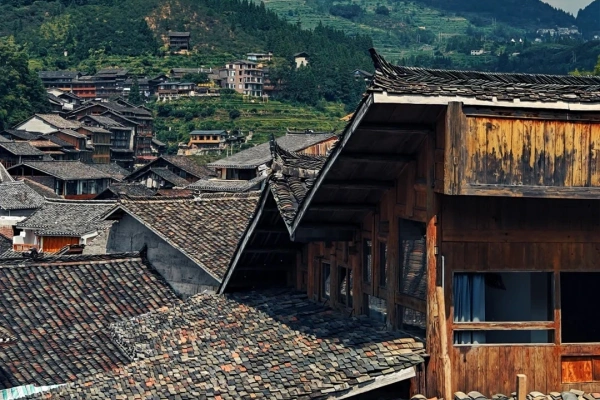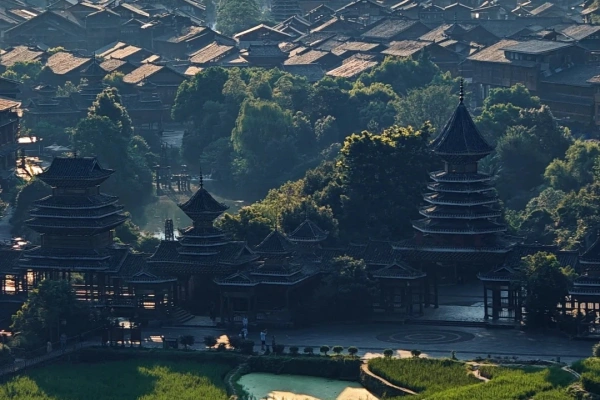Sanjiang Dongtian Palace
Historical Overview
Sanjiang Dongtian Palace has a history closely tied to the Dong community's efforts to preserve and showcase their culture. It was constructed with the aim of being a central place to honor their ancestors and pass down traditional knowledge. Over the years, it has undergone several renovations and expansions. In the early stages, local Dong craftsmen and elders collaborated to design and build the basic structures based on ancient Dong architectural principles. As time went on, with the increasing recognition of the Dong culture, more resources were invested to enhance the palace, adding new exhibition areas and improving the overall facilities.
Structural Layout
The palace complex is laid out in a way that reflects the Dong people's connection with nature and their social hierarchy. The main buildings are arranged around a central courtyard, which serves as a gathering place for various cultural activities. The entrance leads to a grand hall that houses statues of important Dong ancestors and deities. Surrounding this central hall are smaller pavilions and corridors that connect different exhibition spaces. These areas are dedicated to showcasing various aspects of Dong life, such as traditional clothing, handicrafts, and musical instruments. The layout also incorporates natural elements like small ponds and gardens, creating a harmonious and serene environment.

Major Attractions
The Grand Ancestral Hall: This is the heart of Sanjiang Dongtian Palace. It features a towering wooden structure with elaborate carvings on the beams and pillars. Inside, there are life - sized statues of Dong ancestors, along with detailed inscriptions about their lives and contributions. The hall is often used for important ceremonies and rituals.
Dong Traditional Clothing Exhibition: Here, visitors can see a wide variety of Dong traditional costumes. These garments are known for their vibrant colors, intricate embroidery, and unique patterns. Each piece tells a story about the wearer's family, social status, and regional origin within the Dong community.
Musical Instrument Pavilion: The Dong people are famous for their rich musical heritage. This pavilion displays a collection of traditional Dong musical instruments, including lusheng (a reed - pipe wind instrument), niujiaqin (a stringed instrument), and various types of drums. Visitors can even listen to recordings of traditional Dong music played on these instruments.
Handicraft Workshop: This area allows visitors to witness Dong craftsmen at work. They can see how traditional handicrafts such as paper - cutting, bamboo weaving, and silver jewelry making are created. Some workshops also offer hands - on experiences for visitors to try their hand at these ancient crafts.
Suggested Itineraries
Quick Cultural Glimpse (1 - 1.5 Hours)
Start at the Grand Ancestral Hall (30 mins) to get an understanding of the Dong's ancestral worship. Then, head to the Dong Traditional Clothing Exhibition (20 mins) to admire the beautiful costumes. Finally, visit the Musical Instrument Pavilion (20 mins) to learn about Dong music. Highlights: Ancestral hall, traditional clothing, and musical instruments.
In - Depth Cultural Exploration (2 - 3 Hours)
Begin with the Grand Ancestral Hall (40 mins). After that, explore the Dong Traditional Clothing Exhibition (30 mins) and the Handicraft Workshop (40 mins) to see both the finished products and the crafting process. End with a visit to the Musical Instrument Pavilion (30 mins). Highlights: Comprehensive view of Dong culture, including clothing, handicrafts, and music.
Full - Day Immersion (Full Day)
Morning: Start at the Grand Ancestral Hall (1 hour). Then, move on to the Dong Traditional Clothing Exhibition (1 hour) and the Handicraft Workshop (1.5 hours).
Afternoon: Visit the Musical Instrument Pavilion (1 hour) and participate in any ongoing cultural activities or performances in the central courtyard (1.5 hours).
Evening: If there are evening cultural shows or rituals, attend them to experience the Dong culture in a more lively setting. Highlights: A complete immersion in Dong culture, from history to daily life and performances.
Ticket Purchase
Online: Tickets can be booked through the official website of Sanjiang Dongtian Palace or popular travel platforms. It is advisable to book in advance, especially during peak tourist seasons, to avoid long queues.
On - Site: Tickets are also available at the palace's ticket office. However, during busy periods, there may be long waiting times.
Prices: Standard adult tickets are usually priced at a reasonable amount. There are discounts for students, seniors, and children. Special group tickets are also available for large tourist groups.
Guided Tours: Guided tours are offered in multiple languages, including English and Chinese. The cost of a guided tour varies depending on the duration and the language of the tour.

Transportation
By Bus: There are regular bus services that connect Sanjiang Dongtian Palace to major cities and towns in the region. Visitors can check the local bus schedules to find the most convenient route.
By Taxi: Taxis are readily available in nearby cities and towns. Visitors can simply tell the taxi driver the name of the palace, "Sānjiāng Dòngtiāngōng" (三江侗天宫), to reach the destination.
Self - Drive: For those who prefer to drive, there is parking available near the palace. The roads leading to the palace are well - maintained, but it is advisable to check the traffic conditions before setting off.
Best Time & Tips
Avoid Crowds: Peak tourist seasons are usually during national holidays and summer vacations. To avoid large crowds, it is better to visit on weekdays or during the off - peak seasons.
Weather: The best time to visit depends on personal preferences. Spring and autumn offer mild weather, which is ideal for outdoor exploration around the palace. Summer can be hot and humid, while winter may be cold, but the palace's indoor exhibitions provide a comfortable environment regardless of the weather.
Essentials: Bring a camera to capture the beautiful architecture and cultural displays. Comfortable walking shoes are a must as there is a lot of walking involved within the palace complex. It is also a good idea to bring a small bottle of water, especially during hot weather.
Photography: Photography is generally allowed in most areas of the palace, but flash photography may be prohibited in some exhibition halls to protect the artifacts. Tripods and selfie sticks may also be restricted in crowded areas.
Respect Local Customs: When visiting the palace, visitors should respect the local Dong customs and traditions. For example, during religious ceremonies or rituals, it is important to follow the instructions of the staff and maintain a respectful attitude.
What Our Clients Say?
Based on 10,000+ traveler reviews












